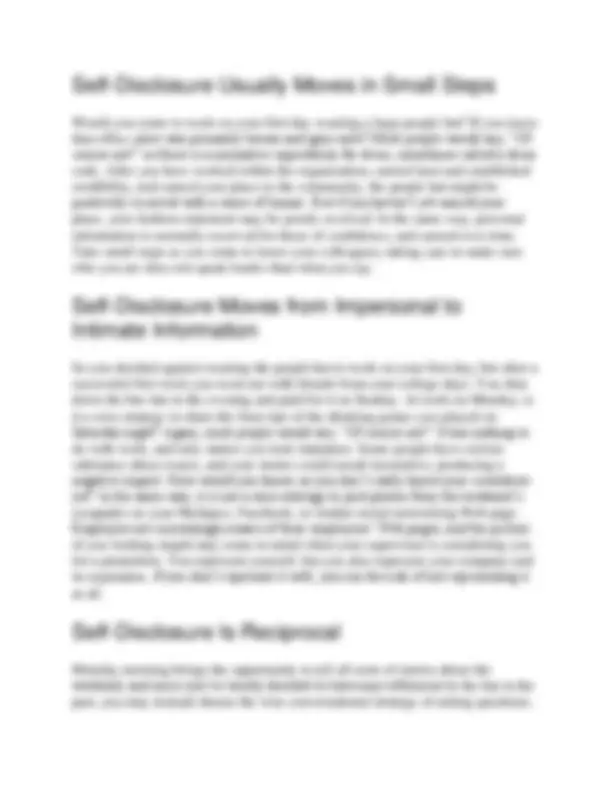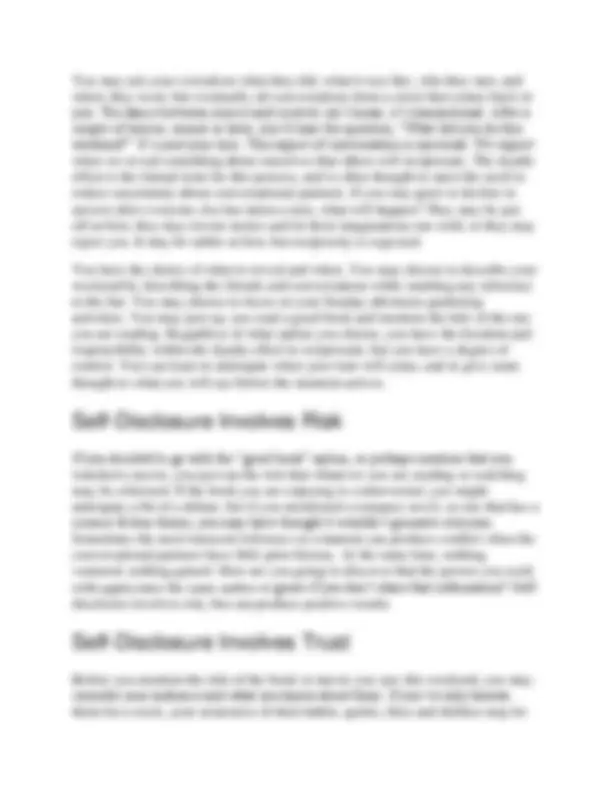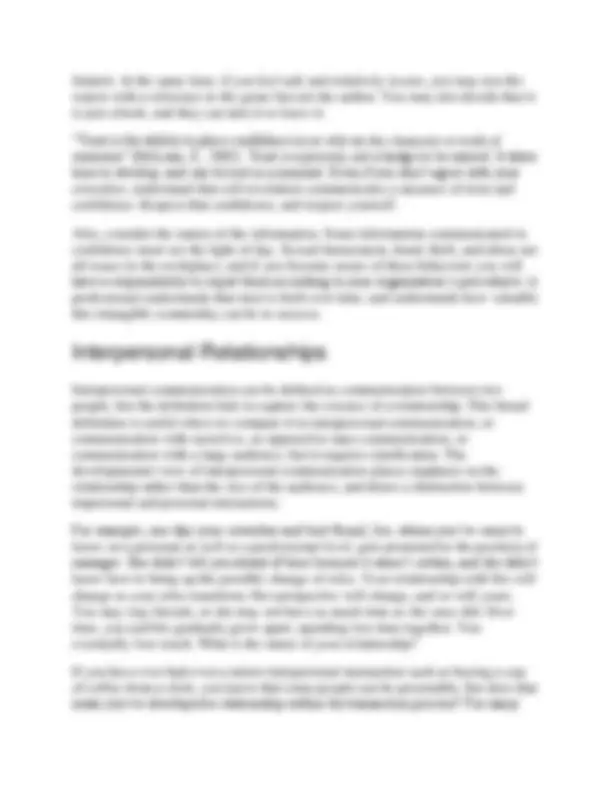






Study with the several resources on Docsity

Earn points by helping other students or get them with a premium plan


Prepare for your exams
Study with the several resources on Docsity

Earn points to download
Earn points by helping other students or get them with a premium plan
Community
Ask the community for help and clear up your study doubts
Discover the best universities in your country according to Docsity users
Free resources
Download our free guides on studying techniques, anxiety management strategies, and thesis advice from Docsity tutors
complete lecture notes on social penetration theory in business communication course
Typology: Study notes
1 / 8

This page cannot be seen from the preview
Don't miss anything!





Learning Objectives
Recognize that you are unknown to your supervisor and vice versa. Start with superficial conversations that are neutral and nonthreatening, but demonstrate a willingness to engage in communication. Silence early in a relationship can be a sign of respect, but it can also send the message that you are fearful, shy, or lack confidence. It can be interpreted as an unwillingness to communicate, and may actually discourage interaction. If the supervisor picks up the conversation, keep your responses short and light. If not, keep an upbeat attitude and mention the weather. Over time, the conversations may gradually grow to cross topics beyond the scope of the office, and a relationship may form that involves trust. To a degree, you and your coworkers learn to predict one another’s responses and relax in the knowledge of mutual respect. If, however, you skip from superficial to intimate topics too quickly, you run risk of violating normative expectations. Trust takes time, and with that comes empathy and understanding. But if you share with your supervisor your personal struggles on day one, it may erode your credibility. According to the social penetration theory, people go from superficial to intimate conversations as trust develops through repeated, positive interactions. Self-disclosure is “information, thoughts, or feelings we tell others about ourselves that they would not otherwise know” (McLean, S., 2005). Taking it step by step, and not rushing to self-disclose or asking personal questions too soon, can help develop positive business relationships.
Write down five terms that describe your personal self, and five terms that describe your professional self. Once you have completed your two lists, compare the results. They may have points that overlap, or may have words that describe you in your distinct roles that are quite different. This difference can be easy to address, but at times it can be a challenge to maintain. How much of “you” do you share in the workplace? Our personal and professional lives don’t exist independently, and in many ways are interdependent. How do people know more about us? We communicate information about ourselves, whether or not we are aware of it. You cannot not communicate (Watzlawick, P., 1993). From your internal monologue and intrapersonal communication, to verbal and nonverbal communication, communication is constantly occurring. What do you communicate about yourself by the clothes (or brands) you wear, the tattoos you display, or the piercing you remove before you enter the workplace? Self-disclosure is a process by which you intentionally communicate information to others, but can involve unintentional, but revealing slips. Steven Beebe, Susan Beebe, and Mark Redmond offer us five principles of self-disclosure that remind us that communication is an integral part of any business or organizational setting. Let’s discuss them one by one (Beebe, S., Beebe S., and Redmond, M., 2002).
You may ask your coworkers what they did, what it was like, who they met, and where they went, but eventually all conversations form a circle that comes back to you. The dance between source and receiver isn’t linear, it’s transactional. After a couple of stories, sooner or later, you’ll hear the question, “What did you do this weekend?” It’s now your turn. This aspect of conversation is universal. We expect when we reveal something about ourselves that others will reciprocate. The dyadic effect is the formal term for this process, and is often thought to meet the need to reduce uncertainty about conversational partners. If you stay quiet or decline to answer after everyone else has taken a turn, what will happen? They may be put off at first, they may invent stories and let their imaginations run wild, or they may reject you. It may be subtle at first, but reciprocity is expected. You have the choice of what to reveal and when. You may choose to describe your weekend by describing the friends and conversations while omitting any reference to the bar. You may choose to focus on your Sunday afternoon gardening activities. You may just say you read a good book and mention the title of the one you are reading. Regardless of what option you choose, you have the freedom and responsibility within the dyadic effect to reciprocate, but you have a degree of control. You can learn to anticipate when your turn will come, and to give some thought to what you will say before the moment arrives.
If you decided to go with the “good book” option, or perhaps mention that you watched a movie, you just ran the risk that whatever you are reading or watching may be criticized. If the book you are enjoying is controversial, you might anticipate a bit of a debate, but if you mentioned a romance novel, or one that has a science fiction theme, you may have thought it wouldn’t generate criticism. Sometimes the most innocent reference or comment can produce conflict when the conversational partners have little prior history. At the same time, nothing ventured, nothing gained. How are you going to discover that the person you work with appreciates the same author or genre if you don’t share that information? Self- disclosure involves risk, but can produce positive results.
Before you mention the title of the book or movie you saw this weekend, you may consider your audience and what you know about them. If you’ve only known them for a week, your awareness of their habits, quirks, likes and dislikes may be
limited. At the same time, if you feel safe and relatively secure, you may test the waters with a reference to the genre but not the author. You may also decide that it is just a book, and they can take it or leave it. “Trust is the ability to place confidence in or rely on the character or truth of someone” (McLean, S., 2005). Trust is a process, not a badge to be earned. It takes time to develop, and can be lost in a moment. Even if you don’t agree with your coworker, understand that self-revelation communicates a measure of trust and confidence. Respect that confidence, and respect yourself. Also, consider the nature of the information. Some information communicated in confidence must see the light of day. Sexual harassment, fraud, theft, and abuse are all issues in the workplace, and if you become aware of these behaviors you will have a responsibility to report them according to your organization’s procedures. A professional understands that trust is built over time, and understands how valuable this intangible commodity can be to success.
Interpersonal communication can be defined as communication between two people, but the definition fails to capture the essence of a relationship. This broad definition is useful when we compare it to intrapersonal communication, or communication with ourselves, as opposed to mass communication, or communication with a large audience, but it requires clarification. The developmental view of interpersonal communication places emphasis on the relationship rather than the size of the audience, and draws a distinction between impersonal and personal interactions. For example, one day your coworker and best friend, Iris, whom you’ve come to know on a personal as well as a professional level, gets promoted to the position of manager. She didn’t tell you ahead of time because it wasn’t certain, and she didn’t know how to bring up the possible change of roles. Your relationship with Iris will change as your roles transform. Her perspective will change, and so will yours. You may stay friends, or she may not have as much time as she once did. Over time, you and Iris gradually grow apart, spending less time together. You eventually lose touch. What is the status of your relationship? If you have ever had even a minor interpersonal transaction such as buying a cup of coffee from a clerk, you know that some people can be personable, but does that mean you’ve developed a relationship within the transaction process? For many
know our place and role within the organization, accurately predict those within our proximity, and create a sense of safety and belonging. Family for many is the first experience in interpersonal relationships, but as we develop professionally, our relationships at work may take on many of the attributes we associate with family communication. We look to each other with similar sibling rivalries, competition for attention and resources, and support. The workplace and our peers can become as close, or closer, than our birth families, with similar challenges and rewards.
Interpersonal relationships are an important part of the work environment. We come to know one another gradually. Self-disclosure involves risk and reward, and is a normal part of communication.
Kellerman, K., & Reynolds, R. (1990). When ignorance is bliss: The role of motivation to reduce uncertainty in uncertainty reduction theory. Human Communication Research , 17 , 5–75. McLean, S. (2005). The basics of interpersonal communication (p. 112). Boston, MA: Allyn & Bacon. Sunnafrank, M. (1986). Predicted outcome value during initial interactions: A reformulation of uncertainty reduction theory. Human Communication Research , 3–33. Watzlawick, P. (1993). The language of change: Elements of therapeutic communication. New York, NY: W. W. Norton & Company.